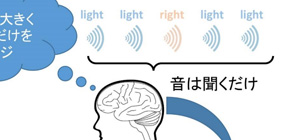
English listening skills improve unconsciously by using brain waves
Enhancing brain activity that responds to differences between ‘L’ and ‘R’ sounds through neurofeedback method
A group of researchers from the Center for Information and Neural Networks (CiNet), National Institute of Information and Communications Technology (NICT), and the Graduate School of Information Science and Technology, Osaka University, together with Hokkaido University, developed a neurofeedback method that can improve English listening skills unconsciously by using brain waves.
For their neurofeedback method, they used mismatch negativity (MMN), a particular brain wave pattern that happens when a sequence of repetitive sounds is interrupted by an occasional sound that differs in frequency. For example, when the words “light” and “right” are randomly presented at a rate of 4 to 1, when “right” is played, this pattern occurs. When the difference in sounds is big, the MMN amplitude is large, and when the difference is small, the MMN amplitude is small. Using this characteristic, the size of MMN was shown as a green disc in the experiment.
Participants in the experiment were instructed to make the green disc on the screen large, thereby they became able to distinguish ‘l’ and ‘r’ sounds without being aware of sound differences between these sounds. The participants became to distinguish ‘light’ and ‘right' at a rate of some 90% in 5 days.
Currently, this group is researching ‘l’ and ‘r’ sounds, but it plans to apply this method to other sounds of which native Japanese speakers are usually unable to perceive sound differences. This time, the size of MMN was represented by the size of the green disc; however, if it corresponds to, for example, a speed of race car, learners may be able to discriminate sounds just by playing a race car game.
Abstract
When people learn foreign languages, they find it difficult to perceive speech sounds that are nonexistent in their native language, and extensive training is consequently necessary. Our previous studies have shown that by using neurofeedback based on the mismatch negativity event-related brain potential, participants could unconsciously achieve learning in the auditory discrimination of pure tones that could not be consciously discriminated without the neurofeedback. Here, we examined whether mismatch negativity neurofeedback is effective for helping someone to perceive new speech sounds in foreign language learning. We developed a task for training native Japanese speakers to discriminate between ‘l’ and ‘r’ sounds in English, as they usually cannot discriminate between these two sounds. Without participants attending to auditory stimuli or being aware of the nature of the experiment, neurofeedback training helped them to achieve significant improvement in unconscious auditory discrimination and recognition of the target words ‘light’ and ‘right’. There was also improvement in the recognition of other words containing ‘l’ and ‘r’ (e.g., ‘blight’ and ‘bright’), even though these words had not been presented during training. This method could be used to facilitate foreign language learning and can be extended to other fields of auditory and clinical research and even other senses.
Figure 1
Figure 2
Figure 3
To learn more about this research, please view the full research report entitled " Unconscious Improvement in Foreign Language Learning Using Mismatch Negativity Neurofeedback: a preliminary study " at this page of the PLOS ONE website.
Related link

